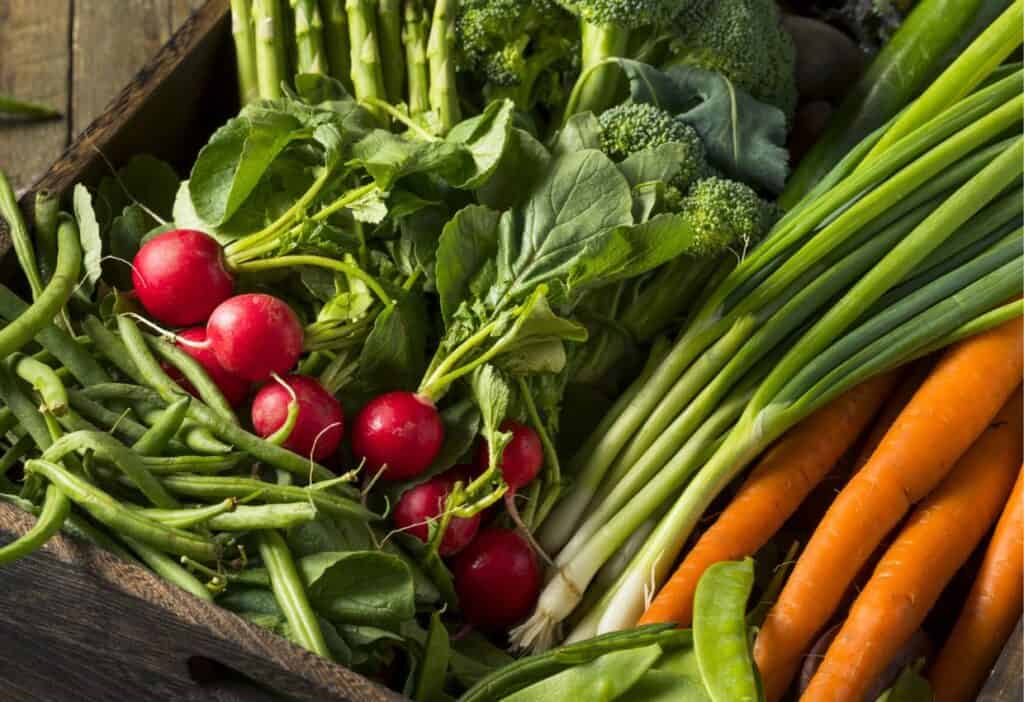Enjoying the best that spring offers does not have to hurt the wallet. Eating seasonally this spring just might be the key to delicious and affordable dining.

As the days grow longer and the temperatures rise, a vast array of spring produce awaits, bursting with the vibrant flavors of the season. Whether you’re a seasoned chef or a novice cook, harnessing the abundance of spring fruits and vegetables can transform ordinary meals into extraordinary culinary experiences while keeping your wallet happy.
The bounty of spring
Spring brings a bounty of fresh produce to the table. These seasonal gems pack a nutritional punch and offer versatility in the kitchen, all without breaking the bank. Some of spring’s delicious and affordable offerings include asparagus, arugula, bananas, broccoli, bok choy, cabbage, carrots, cauliflower, chives, garlic, green beans, leeks, lemons, lettuce, mushrooms, peas, pineapples, radishes, spinach, spring onions and strawberries.
One big perk of eating produce that is in season is that it’s also at its most affordable. Plants grown in their natural season require fewer artificial inputs like heating, lighting and pesticides, which can also contribute to a lower environmental footprint and cost. By utilizing these fresh spring ingredients, you can maximize your budget and indulge in the best the season offers.
Maximizing fresh spring produce
Making the most of fresh spring produce is not only about what you buy but also how you shop and utilize your ingredients. Here are some tips to help you make the most of the season’s crops while staying within your budget.
Buy in bulk: Certain spring produce items like carrots and garlic have a longer shelf life and can be purchased in larger quantities at a lower cost per unit. However, exercise caution with perishable items like berries or leafy greens, as buying more than you can consume before they spoil leads to waste and negates your savings.
Utilize every part: Don’t let any part of your spring produce go to waste. For example, carrot tops can be used to make pesto, and broccoli stems can be turned into flavorful soups or used in stir-fries. By using every part of the plant, you not only maximize your investment but also reduce food waste.
Preserve for later: If you come across a great deal on a particular spring ingredient, consider preserving it for later use. You can freeze berries for smoothies or jams, pickle cabbage or radishes, or even make homemade sauces and soups to enjoy throughout the year. Preservation methods like freezing, canning and pickling allow you to enjoy your favorite spring produce long after the season has ended.
By following these tips and getting creative in the kitchen, you can stretch your budget while still enjoying the delicious flavors of spring. With some planning and resourcefulness, you can make the most of what the season has to offer without overspending.
From farm to table
Local farmers’ markets are gold mines for finding fresh, affordable spring produce. Items sold here are often priced lower than grocery stores because the growers sell them directly, cutting out the middleman. Additionally, buying from these markets supports local agriculture, ensuring that these resources remain available in your community.
When exploring local farmers’ markets for fresh spring produce, don’t shy away from engaging with vendors about potential discounts, especially if you’re interested in bulk purchases or eyeing produce that needs to be sold by day’s end. A friendly conversation can open doors to savings. As the market day winds down, vendors are often more willing to negotiate to avoid taking perishable goods back home.
Delicious and affordable dishes
With abundant spring produce at your fingertips, the sky’s the limit regarding the tasty dishes you can whip up in your kitchen. Here are some mouthwatering recipe ideas that won’t break the bank:
Asparagus and mushroom risotto: Combine asparagus spears and earthy mushrooms with creamy Arborio rice for a luxurious yet affordable meal. Finish with a sprinkle of Parmesan cheese for added richness.
Strawberry spinach salad: Toss fresh spinach leaves, sliced strawberries and toasted almonds for a refreshing and nutrient-packed salad. Drizzle with a balsamic vinaigrette to enhance the flavors.
Bok choy stir-fry: Stir-frying bok choy with garlic and soy sauce creates a quick and satisfying side dish or light meal. Add tofu, chicken or shrimp for a protein boost.
Spring vegetable pasta: Combine seasonal favorites like peas, carrots and leeks with al dente pasta for a vibrant and satisfying meal. Finish with a squeeze of lemon juice and a sprinkle of freshly grated Pecorino Romano cheese.
Spring onion frittata: Whisk together eggs, spring onions and your favorite cheese, then bake until golden and fluffy for a satisfying breakfast, brunch or light dinner option.
Final thoughts
Make the most of this season’s delicious fruit and vegetables to create meals that are delightful, nutritious and kind to the planet and pockets. Here’s to a spring filled with joy, health and deliciousness — may your table always be vibrant with the colors and flavors of the season.
Kristen Wood is a photographer, recipe developer, food writer and the creative force behind MOON and spoon and yum. She is also the author of Vegetarian Family Cookbook, Fermented Hot Sauce Cookbook and Hot Sauce Cookbook for Beginners. A certified functional nutrition expert, Kristen’s work has graced the pages of Elle, Healthline, Martha Stewart, Chicago Sun-Times, Yoga Journal and more, establishing her as a trusted voice in the food industry.